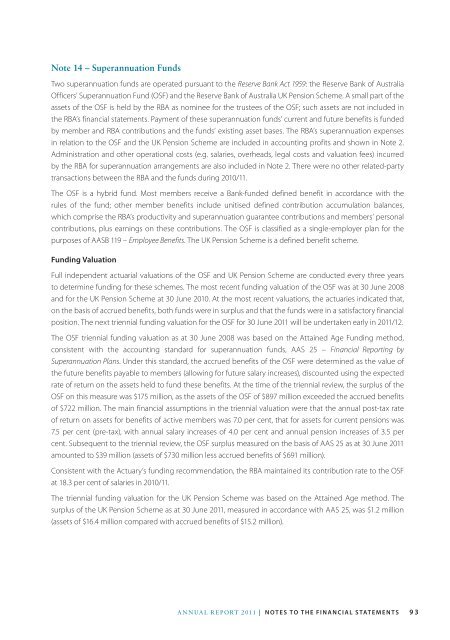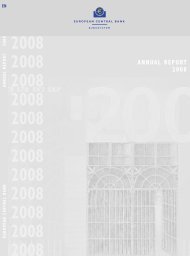Reserve Bank of Australia Annual Report 2011
Reserve Bank of Australia Annual Report 2011
Reserve Bank of Australia Annual Report 2011
You also want an ePaper? Increase the reach of your titles
YUMPU automatically turns print PDFs into web optimized ePapers that Google loves.
Note 14 – Superannuation Funds<br />
Two superannuation funds are operated pursuant to the <strong>Reserve</strong> <strong>Bank</strong> Act 1959: the <strong>Reserve</strong> <strong>Bank</strong> <strong>of</strong> <strong>Australia</strong><br />
Officers’ Superannuation Fund (OSF) and the <strong>Reserve</strong> <strong>Bank</strong> <strong>of</strong> <strong>Australia</strong> UK Pension Scheme. A small part <strong>of</strong> the<br />
assets <strong>of</strong> the OSF is held by the RBA as nominee for the trustees <strong>of</strong> the OSF; such assets are not included in<br />
the RBA’s financial statements. Payment <strong>of</strong> these superannuation funds’ current and future benefits is funded<br />
by member and RBA contributions and the funds’ existing asset bases. The RBA’s superannuation expenses<br />
in relation to the OSF and the UK Pension Scheme are included in accounting pr<strong>of</strong>its and shown in Note 2.<br />
Administration and other operational costs (e.g. salaries, overheads, legal costs and valuation fees) incurred<br />
by the RBA for superannuation arrangements are also included in Note 2. There were no other related-party<br />
transactions between the RBA and the funds during 2010/11.<br />
The OSF is a hybrid fund. Most members receive a <strong>Bank</strong>-funded defined benefit in accordance with the<br />
rules <strong>of</strong> the fund; other member benefits include unitised defined contribution accumulation balances,<br />
which comprise the RBA’s productivity and superannuation guarantee contributions and members’ personal<br />
contributions, plus earnings on these contributions. The OSF is classified as a single-employer plan for the<br />
purposes <strong>of</strong> AASB 119 – Employee Benefits. The UK Pension Scheme is a defined benefit scheme.<br />
Funding Valuation<br />
Full independent actuarial valuations <strong>of</strong> the OSF and UK Pension Scheme are conducted every three years<br />
to determine funding for these schemes. The most recent funding valuation <strong>of</strong> the OSF was at 30 June 2008<br />
and for the UK Pension Scheme at 30 June 2010. At the most recent valuations, the actuaries indicated that,<br />
on the basis <strong>of</strong> accrued benefits, both funds were in surplus and that the funds were in a satisfactory financial<br />
position. The next triennial funding valuation for the OSF for 30 June <strong>2011</strong> will be undertaken early in <strong>2011</strong>/12.<br />
The OSF triennial funding valuation as at 30 June 2008 was based on the Attained Age Funding method,<br />
consistent with the accounting standard for superannuation funds, AAS 25 – Financial <strong>Report</strong>ing by<br />
Superannuation Plans. Under this standard, the accrued benefits <strong>of</strong> the OSF were determined as the value <strong>of</strong><br />
the future benefits payable to members (allowing for future salary increases), discounted using the expected<br />
rate <strong>of</strong> return on the assets held to fund these benefits. At the time <strong>of</strong> the triennial review, the surplus <strong>of</strong> the<br />
OSF on this measure was $175 million, as the assets <strong>of</strong> the OSF <strong>of</strong> $897 million exceeded the accrued benefits<br />
<strong>of</strong> $722 million. The main financial assumptions in the triennial valuation were that the annual post-tax rate<br />
<strong>of</strong> return on assets for benefits <strong>of</strong> active members was 7.0 per cent, that for assets for current pensions was<br />
7.5 per cent (pre-tax), with annual salary increases <strong>of</strong> 4.0 per cent and annual pension increases <strong>of</strong> 3.5 per<br />
cent. Subsequent to the triennial review, the OSF surplus measured on the basis <strong>of</strong> AAS 25 as at 30 June <strong>2011</strong><br />
amounted to $39 million (assets <strong>of</strong> $730 million less accrued benefits <strong>of</strong> $691 million).<br />
Consistent with the Actuary’s funding recommendation, the RBA maintained its contribution rate to the OSF<br />
at 18.3 per cent <strong>of</strong> salaries in 2010/11.<br />
The triennial funding valuation for the UK Pension Scheme was based on the Attained Age method. The<br />
surplus <strong>of</strong> the UK Pension Scheme as at 30 June <strong>2011</strong>, measured in accordance with AAS 25, was $1.2 million<br />
(assets <strong>of</strong> $16.4 million compared with accrued benefits <strong>of</strong> $15.2 million).<br />
<strong>Annual</strong> report <strong>2011</strong> | notes to the financial statements<br />
93





![KNOW YOUR NEW GIBRALTAR BANKNOTES - [Home] bThe/b](https://img.yumpu.com/50890985/1/184x260/know-your-new-gibraltar-banknotes-home-bthe-b.jpg?quality=85)
![PAPUA NEW GUINEA - [Home] - Polymer Bank Notes of the World](https://img.yumpu.com/49758743/1/190x143/papua-new-guinea-home-polymer-bank-notes-of-the-world.jpg?quality=85)










